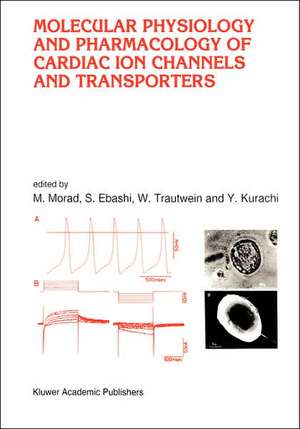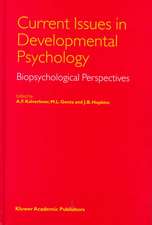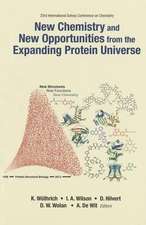Molecular Physiology and Pharmacology of Cardiac Ion Channels and Transporters: Developments in Cardiovascular Medicine, cartea 182
Editat de M. Morad, S. Ebashi, W. Trautwein, Yoshihisa Kurachien Limba Engleză Hardback – 31 aug 1996
| Toate formatele și edițiile | Preț | Express |
|---|---|---|
| Paperback (1) | 1981.18 lei 38-44 zile | |
| SPRINGER NETHERLANDS – 14 oct 2012 | 1981.18 lei 38-44 zile | |
| Hardback (1) | 2138.98 lei 6-8 săpt. | |
| SPRINGER NETHERLANDS – 31 aug 1996 | 2138.98 lei 6-8 săpt. |
Din seria Developments in Cardiovascular Medicine
- 5%
 Preț: 1484.53 lei
Preț: 1484.53 lei - 5%
 Preț: 375.17 lei
Preț: 375.17 lei - 5%
 Preț: 354.10 lei
Preț: 354.10 lei - 5%
 Preț: 1419.03 lei
Preț: 1419.03 lei - 5%
 Preț: 376.43 lei
Preț: 376.43 lei - 5%
 Preț: 1098.27 lei
Preț: 1098.27 lei - 5%
 Preț: 1438.38 lei
Preț: 1438.38 lei - 5%
 Preț: 376.78 lei
Preț: 376.78 lei - 5%
 Preț: 368.37 lei
Preț: 368.37 lei - 5%
 Preț: 380.25 lei
Preț: 380.25 lei - 5%
 Preț: 2117.58 lei
Preț: 2117.58 lei - 5%
 Preț: 367.28 lei
Preț: 367.28 lei - 5%
 Preț: 366.56 lei
Preț: 366.56 lei - 5%
 Preț: 371.10 lei
Preț: 371.10 lei - 5%
 Preț: 370.94 lei
Preț: 370.94 lei - 5%
 Preț: 783.18 lei
Preț: 783.18 lei - 5%
 Preț: 713.18 lei
Preț: 713.18 lei - 5%
 Preț: 1098.27 lei
Preț: 1098.27 lei - 5%
 Preț: 375.49 lei
Preț: 375.49 lei - 5%
 Preț: 373.47 lei
Preț: 373.47 lei - 5%
 Preț: 723.93 lei
Preț: 723.93 lei - 5%
 Preț: 1104.13 lei
Preț: 1104.13 lei - 5%
 Preț: 2117.20 lei
Preț: 2117.20 lei - 5%
 Preț: 716.09 lei
Preț: 716.09 lei - 5%
 Preț: 372.03 lei
Preț: 372.03 lei - 5%
 Preț: 722.33 lei
Preț: 722.33 lei - 5%
 Preț: 660.07 lei
Preț: 660.07 lei - 5%
 Preț: 375.34 lei
Preț: 375.34 lei - 5%
 Preț: 1423.22 lei
Preț: 1423.22 lei - 5%
 Preț: 715.35 lei
Preț: 715.35 lei - 5%
 Preț: 790.69 lei
Preț: 790.69 lei - 5%
 Preț: 720.68 lei
Preț: 720.68 lei - 5%
 Preț: 3185.49 lei
Preț: 3185.49 lei - 5%
 Preț: 1418.27 lei
Preț: 1418.27 lei - 5%
 Preț: 784.64 lei
Preț: 784.64 lei - 5%
 Preț: 714.63 lei
Preț: 714.63 lei - 5%
 Preț: 370.74 lei
Preț: 370.74 lei - 5%
 Preț: 376.22 lei
Preț: 376.22 lei - 5%
 Preț: 660.85 lei
Preț: 660.85 lei - 5%
 Preț: 368.37 lei
Preț: 368.37 lei
Preț: 2138.98 lei
Preț vechi: 2251.56 lei
-5% Nou
Puncte Express: 3208
Preț estimativ în valută:
409.29€ • 445.98$ • 344.89£
409.29€ • 445.98$ • 344.89£
Carte tipărită la comandă
Livrare economică 23 aprilie-07 mai
Preluare comenzi: 021 569.72.76
Specificații
ISBN-13: 9780792339137
ISBN-10: 0792339134
Pagini: 602
Ilustrații: XXII, 602 p.
Dimensiuni: 210 x 279 x 33 mm
Greutate: 1.29 kg
Ediția:1996
Editura: SPRINGER NETHERLANDS
Colecția Springer
Seria Developments in Cardiovascular Medicine
Locul publicării:Dordrecht, Netherlands
ISBN-10: 0792339134
Pagini: 602
Ilustrații: XXII, 602 p.
Dimensiuni: 210 x 279 x 33 mm
Greutate: 1.29 kg
Ediția:1996
Editura: SPRINGER NETHERLANDS
Colecția Springer
Seria Developments in Cardiovascular Medicine
Locul publicării:Dordrecht, Netherlands
Public țintă
ResearchCuprins
One.- Section I: Channels and channel proteins.- 1: Introduction.- 1. Overview: channels and channel proteins.- 2: A pacemaker channel.- 2. The hyperpolarization-activated inward channel and cardiac pacemaker activity.- 3. The hyperpolarization-activated (If) current: autonomic regulation and the control of pacing.- 3: The cardiac Na+ channel.- 4. Current understanding of the structure of the voltage gated sodium channel.- 5. ?-adrenergic regulation of cardiac Na+ channel.- 4: The L-type cardiac Ca2+ channel.- 6. L-type calcium channel structure and function.- 7. L-type Ca channel biophysics.- 8. ?-adrenergic and muscarinic regulation of L-type calcium current.- 9. Regulation of cardiac Ca2+ channels by cGMP and NO.- 5: The cardiac K+ channel.- 10. Diversity of voltage-dependent K channels.- 11. Cloned human heart delayed rectifier K+ channels.- 12. Primary structure and biophysical properties of inward rectifying K+ channel family.- 13. Ca2+-dependent transient outward current in mammalian heart.- 14. Delayed potassium channels in the heart: regulatory and molecular properties.- 15. Muscarinic and purinergic regulation of cardiac K+ channels.- 6: Cardiac Cl? channels.- 16. Chloride channels in heart.- 7: Cardiac ion channels not gated by voltage.- 17. Properties of cardiac ATP-sensitive potassium channels.- 18. Physiological and molecular properties of cardiac gap junctions.- 19.Volume-regulated cardiac ion channels.- 20. Regulation of cardiac activity by ATP, a purine agonist.- Section II: Ion channels in cardiovascular development.- 1.- 21. Developmental aspects of cardiac ion channels.- 22. Developmental changes and regulation of L-type calcium channels of myocardial cells and vascular smooth muscle cells.- Section III: Pharmacology of ion channels.- 1.- 23.Pharmacology of the calcium channel antagonists.- 24. Interactions of calcium antagonists and agonists with calcium channels in muscle cells.- 25. Pharmacological regulation of the cardiac ATP-sensitive K+ channel.- 26. Fatty acids and cardiac K+ channels.- 27. Sodium channels and block.- Section IV: Ion channels and cardiac pathology.- 1.- 28. Afterdepolarizations triggered rhythms and cardiac arrhythmias.- 29. Transient inward current and triggered activity.- 30. The Na+-activated K+ channel.- 31. Regulation of cardiac ATP-sensitive K channels during ischemia, hypoxia and impaired metabolism.- Two.- Section I: Molecular aspects of Ca2+ release.- 1.- 32. Signaling of calcium release in cardiac muscle.- 33. Local calcium transients in voltage-clamped cardiac cells: evoked ‘calcium sparks’.- 34. Sarcoplasmic recticulum ryanodine receptor/Ca2+ release channel: a functional perspective.- 35. Molecular structure of calcium release channels.- Section II: Molecular steps in cardiac relaxation.- 1.- 36. Sarcoplasmic reticulum Ca2+ ATPases.- 37. Molecular structure and function of phospholamban.- 2: Molecular biology and physiology of Na+-Ca2+ exchange.- 38. Na+-Ca2+ exchanger: molecular aspects.- 39. Na/Ca exchanger: molecular and cellular characteristics.- 40. The functional significance of sodium-calcium exchange.- 41.The physiology of the Na-Ca exchange.- 3: Contraction-relaxation regulation.- 42. Regulation of cardiac relaxation.- 43. Evaluation of changes in myofibrillar Ca2+ sensitivity in intact cardiac cells.- 44. ?-Adrenergic receptor-dependent regulation of myocardial contractility.- 45. Ca transport from the cytoplasm and dynamic cellular Ca balance in cardiac myocytes.- Section III: Regulation of cellular Ca2+ by other transporters.- 1.- 46. Regulation ofintracellular protons: role of Na/H exchange in cardiac myocytes.- 2.- 47. Magnesium homeostasis and cardiac cell function.- 3.- 48. Na-K pump: multiple isoforms and their roles in cardiac functions.










